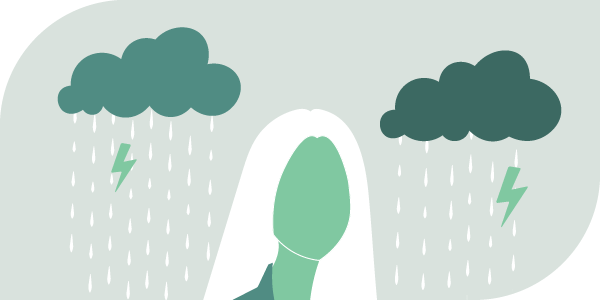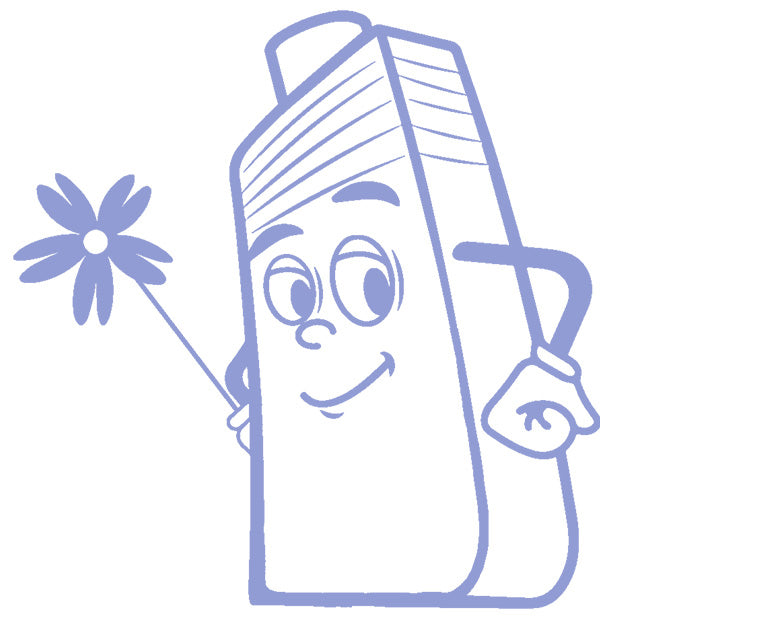Keep reading to learn more about telogen effluvium, what causes sudden hair loss, the most effective telogen effluvium treatment, and our telogen effluvium regrowth plan.
Index
What is Telogen Effluvium?
It’s normal to lose up to 150 strands of hair per day. But if you experience a stressful event (more on those later), you might end up with a case of telogen effluvium down the line.
So just what is telogen effluvium? It is the most common cause of diffuse thinning and sudden hair loss and it’s the second most common form of hair loss after androgenic alopecia. Telogen effluvium occurs when a stressful event triggers more hairs than usual to move from the growth phase to the resting phase of the hair growth cycle. Three to four months after the triggering event (once those hairs reach the shedding phase of the hair cycle), diffuse thinning occurs.
Telogen effluvium usually lasts for around six months. Typically it resolves on its own, but there are some things you can do to help with telogen effluvium regrowth (more on that later). In most cases, telogen effluvium affects less than 50% of the hair on your head. So if you feel like all of your hair is falling out, don’t worry! It’s not!
What Are the Symptoms of Telogen Effluvium?
Diffuse Thinning
Diffuse thinning is one of the defining characteristics of telogen effluvium. Unlike with androgenic alopecia (where you see more of a receding hairline or thinning at the crown), telogen effluvium causes diffuse thinning all over. This diffuse thinning is harder to recognize at first, but you might notice that your ponytail is smaller or your part is wider than usual.
Sudden Hair Loss
Telogen effluvium hair loss usually occurs fast. This is why it feels so traumatic to people who go through it. This type of sudden hair loss may have you finding clumps of hair in the shower drain or in your hair brush.
Remember: only a doctor can diagnose you with telogen effluvium. If you’re experiencing unusual hair shedding and you suspect you have telogen effluvium, visit your dermatologist.
4 Causes of Telogen Effluvium
Telogen effluvium can have many causes, including:

1. Diet
If you’re missing out on key nutrients – particularly iron – you might experience diffuse shedding.
2. Stress
Stress is another major cause of sudden hair loss. But we’re not just talking about emotional stress here! Physical stress brought on by a major surgery, injuries, or even a crash diet can lead to telogen effluvium as well.
3. Pregnancy and Childbirth
Many women experience sudden hair loss after giving birth, aka postpartum hair loss.
4. Medication
Certain drugs can cause diffuse thinning. If you’re worried that your medication is causing sudden hair loss, talk to your doctor.
(Read more about the various causes of hair loss in women and men.)
Is There a Difference Between Anagen Effluvium and Telogen Effluvium?

Yes, there is a difference between anagen effluvium and telogen effluvium. During telogen effluvium, hair is shed during the shedding phase of the hair cycle, otherwise known as the telogen phase (hence the name). Anagen effluvium, on the other hand, occurs during the growth or anagen phase of the hair growth cycle.
Telogen effluvium shows up as sudden hair loss three months after the triggering incident, whereas anagen effluvium appears as diffuse thinning only days after the triggering incident. The most common cause of anagen effluvium is undergoing chemotherapy treatment.
Is Telogen Effluvium Hereditary?
No, telogen effluvium is not hereditary. If a close family member has telogen effluvium, that doesn’t mean that you’ll get it as well. Another thing to consider is that sudden hair loss can affect anyone, regardless of their age or gender.
What is Chronic Telogen Effluvium?
Chronic telogen effluvium is defined as diffuse thinning that lasts for more than six months. While this condition is not common, chronic telogen effluvium does look the same as regular telogen effluvium, at least for the first six months. The only way to know if your case of telogen effluvium is chronic is to speak to a doctor about a telogen effluvium treatment.
How Can You Prevent Telogen Effluvium?
Since stress can trigger sudden hair loss, it’s a wise move to learn some stress management techniques to prevent diffuse thinning. Exercise, meditation, journaling and getting plenty of sleep can help reduce stress levels, aid recovery from diffuse shedding or help prevent it in the first place.
Did you know that your diet has an effect on your hair?
What is the Best Telogen Effluvium Treatment?
First things first, the best telogen effluvium “treatment” is to remove the stressor that caused the sudden hair loss in the first place. For example, if a stressful job is causing you to lose your hair, your telogen effluvium treatment may be to consider a different work environment. In some cases, like having a baby, once the triggering event is over, you won’t need to worry about it anymore. Talk to your doctor to pinpoint what caused your case of sudden hair loss so you can work to remove the stressor.
Unfortunately, there is no real medical telogen effluvium treatment. At this time, there are no medications that can speed up the growth phase of the hair cycle. But don’t despair! Telogen effluvium is temporary and your hair will usually regrow in six months to one year.
You can also help your hair recover by following good hair care habits and eating well. So those could be considered forms of telogen effluvium treatment!
7 Steps: Telogen Effluvium Regrowth
1. Consider a Haircut

We’re all attached to our lengths, but hear us out: a haircut can help. Shorter hair has less weight, which means it has more volume. This makes hair look thicker and fuller, even without styling! Plus, trimming off dead split ends can prevent additional breakage.
Don’t worry though, you don’t have to go full pixie haircut mode (unless you want to!). Even cutting your hair into a lob will help disguise sudden hair loss and diffuse thinning.
If you’re open to it, talk to your hairstylist about a haircut that will work best for your hair texture while you wait for telogen effluvium regrowth.
2. Focus on Diet and Nutrition

Eating a hair-healthy diet is the best way to help with telogen effluvium regrowth, particularly if your case was caused by diet in the first place. Make sure you’re eating plenty of whole grains, lean proteins, healthy fats and fruits and veggies.
Hair Growth Supplements can also help you make sure you’re getting all of the nutrients you need for telogen effluvium regrowth. Hair Formula Gummies for Women contain clinically-proven ingredients that help with hair growth, including 5000 mcg biotin. They’re made with natural ingredients and they’re allergy and vegan-friendly. Plus, they come in a delicious flavor so it’s easy to remember to take them!
3. Avoid Heat Styling

One sure-fire way to help with telogen effluvium regrowth is to take better care of the hair that you do have. This way, you’ll prevent breakage (which makes diffuse thinning even worse).
Heat styling is one of the main causes of everyday breakage, so you’ll want to eliminate your curling irons, straighteners and hair dryers from your daily routine as much as possible. When you do decide to use heat to style your hair, make sure you use a heat protectant like Thermal Shield™ Heat Protectant.
4. Avoid Coloring or Bleaching Hair

Similarly, you may want to consider limiting how much you color your hair or stop coloring altogether. Hair bleaching often damages hair, leading to breakage.
If you can’t give up hair color altogether, make sure to incorporate a protein-building deep conditioner into your routine like Protein Repair™ Hair Mask. This treatment utilises hydrolyzed vegetable proteins to rebuild the outer layer of the hair shaft, helping to strengthen hair against breakage and diffuse thinning.
5. Baby Your Hair

Physical stressors on your hair can also lead to more breakage. And no, we don’t mean physical stressors like exercise. For one thing, the way you detangle your hair can make a big difference for hair with diffuse thinning. Make sure to use a tool designed for gently detangling wet hair, like Wet Hair Detangler Brush. Start at your ends and gently work your way towards the scalp, detangling as you go. This will help you to minimise breakage.
Believe it or not, your choice of towel and pillow can also make a big difference. Most pillowcases and towels are made from cotton. However, cotton fibers are actually pretty rough. This means that they rub on hair and that extra friction can lead to tangles, dull hair, dryness and even breakage. Your best bet is to swap them out for products that incorporate super smooth and hair-friendly bamboo like Bamboo Hair Towel Wrap and Silky Bamboo Pillowcase. It’s a small change that can make a big difference when it comes to the health and appearance of your hair!
6. Reduce Stress

As we said before, employing proper stress management techniques can help with telogen effluvium regrowth.
7. Pump Up the Volume

Your choice of products can also help your hair look thicker while you wait for telogen effluvium regrowth. First, consider swapping out your usual shampoo and conditioner for Grow Perfect™ Duo. This shampoo and conditioner set is infused with Anagain™ and organic rosemary oil, which have been proven to extend the growth phase of hair while reducing the shedding phase, effectively leading to improved hair growth and denser hair in as little as three months.
Once your hair is clean, spritz your roots with Grow Perfect™ Thickening Spray. This leave-in scalp treatment uses organic mint oil to stimulate blood flow to the hair follicles, encouraging hair growth. Plus, this treatment actually gives you more volume at the roots immediately, so your hair looks thicker instantly.
Although sudden hair loss can be scary, remember that it’s actually quite common and in most cases, your hair will grow back. But of course, it’s always wise to talk to a doctor just to make sure.
















































































